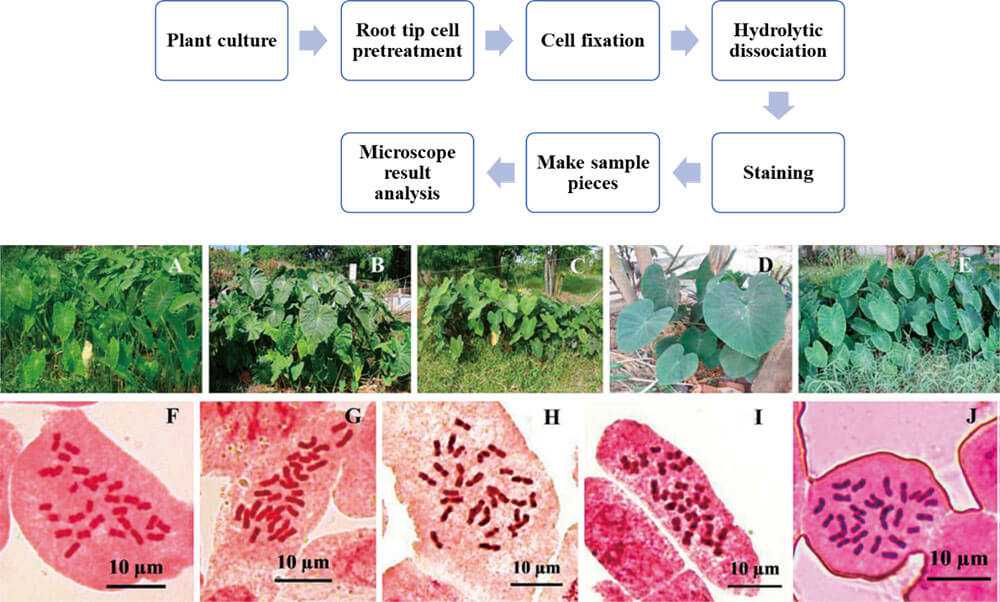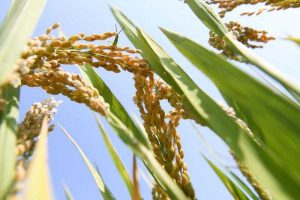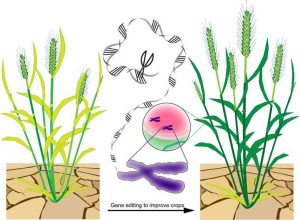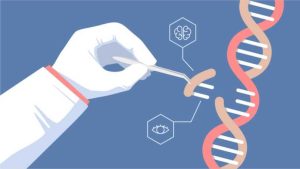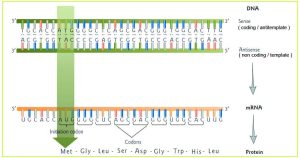Chromosomes are vital structures within cells that serve as carriers of genetic information, determining the traits, growth, and development of an organism.
They are composed of DNA strands wrapped around histone proteins to form chromatin, which later condenses during cell division.
The presence of chromosomes ensures that each cell inherits genetic material in an orderly manner across generations, thereby maintaining the stability of hereditary traits.
The number and shape of chromosomes in each species possess unique characteristics, functioning as genetic identifiers of the organism.
During cell division, chromosomes play a crucial role in ensuring that genetic distribution occurs evenly, allowing daughter cells to function properly.
Research on chromosomes provides deep insights into the mechanisms of heredity, genetic variation, and the potential for abnormalities that may affect the life of an organism.
Definition of Chromosomes
A chromosome is a fine, thread-like structure located within the cell nucleus that functions as the carrier of genetic information passed down from one generation to the next.
It is composed of DNA molecules tightly coiled together with histone proteins, enabling the storage of millions of genetic codes that regulate all activities and vital functions of an organism.
The presence of chromosomes ensures that each cell has precise instructions for growth, development, division, and the inheritance of specific traits.
The number of chromosomes in each species varies but remains constant for that species, making it one of the distinguishing features between different organisms.
Through chromosomes, the process of inheritance occurs in an orderly manner, ensuring genetic stability across generations.
However, alterations or abnormalities in chromosomes can lead to disorders that affect both health and biological functions of a living being.
Structure and Components of Chromosomes
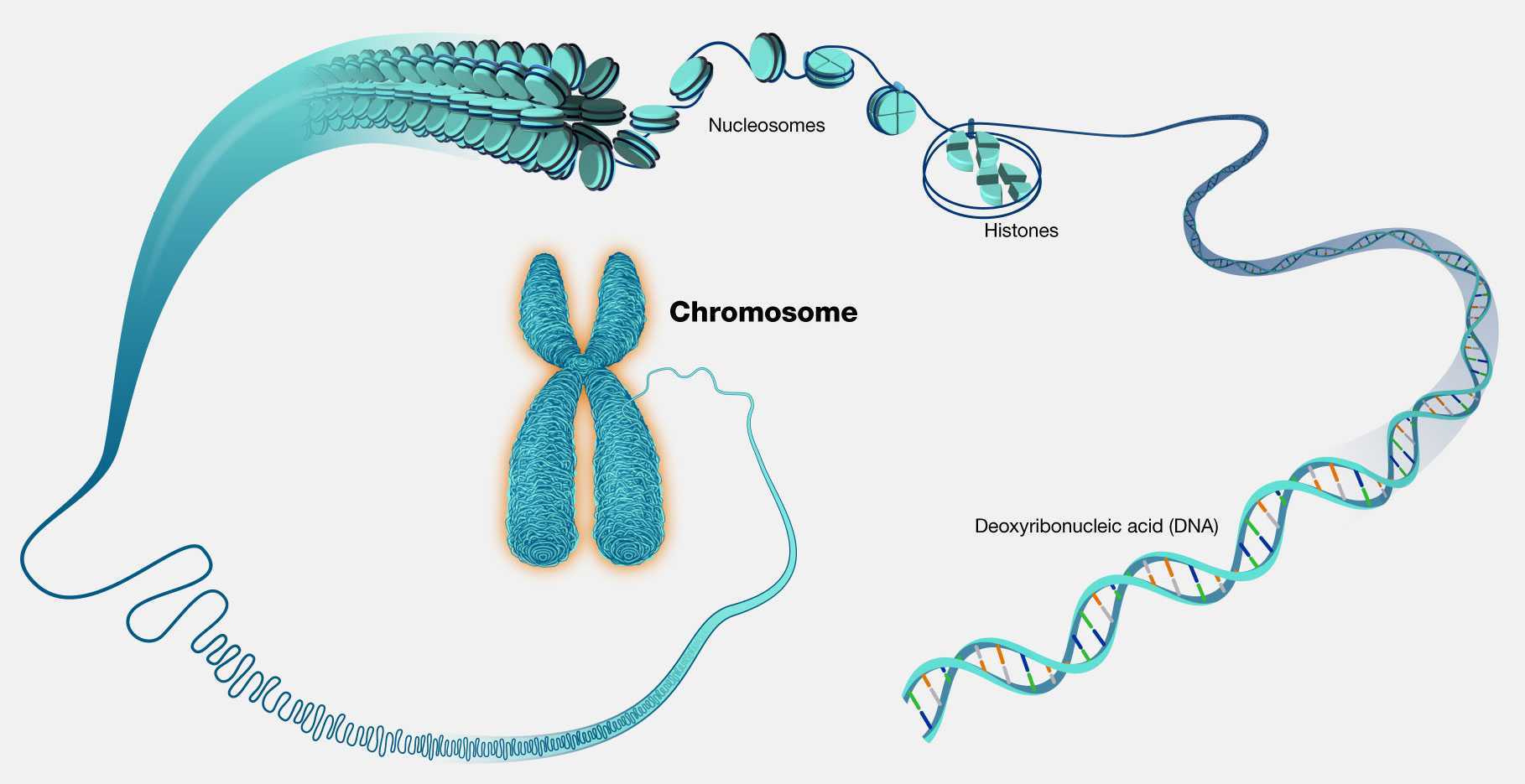
1. Chromatid
A chromatid is a part of the chromosome that forms after DNA replication. When a cell prepares to divide, the chromosome duplicates and produces two identical chromatids. Both are connected at the centromere and are therefore called sister chromatids.
Chromatids carry the same genetic material, ensuring that during cell division, each daughter cell receives a complete copy of DNA.
The role of chromatids is crucial in maintaining consistency of genetic distribution across generations of cells without any loss of information.
In addition, chromatids serve as a key indicator when observing the stages of cell division under a microscope, since their structure becomes clearly visible once chromosomes are condensed.
In genetic research, chromatids provide valuable insights into how genes are inherited and how errors in chromosomal distribution may occur.
Mistakes in chromatid separation can result in chromosomal abnormalities such as trisomy or monosomy, which may affect the health of an organism. Thus, chromatids function not only as structural components but also as essential elements in preserving genetic balance.
2. Centromere
The centromere is the constricted region of a chromosome that holds two sister chromatids together. It becomes the central point of activity during cell division, as it serves as the attachment site for spindle fibers that pull chromatids toward opposite poles of the cell.
The position of the centromere also determines the shape of chromosomes, such as metacentric, submetacentric, acrocentric, or telocentric, each defined by the location of the centromere.
The centromere ensures proper chromosome segregation so that daughter cells receive the correct number of chromosomes.
Moreover, the centromere plays an essential role in maintaining chromosome stability throughout the cell cycle. It is composed of satellite DNA with repetitive sequences and specialized proteins known as kinetochores.
This combination of repetitive DNA and proteins enables the centromere to function effectively in holding chromatids firmly together until the time of separation.
Disruptions in centromere function can lead to abnormal cell division and trigger genetic disorders or cancer. Therefore, the centromere can be regarded as the “anchor” that ensures error-free distribution of genetic material.
3. Telomere
A telomere is the terminal region of a chromosome that functions to protect DNA from damage or loss of information during replication.
Telomeres consist of repetitive base sequences that do not code for genes but are highly important as protective caps. Each time a cell divides, the telomere shortens slightly.
Telomere shortening is closely linked to cellular aging and limits the number of times a cell can divide. By maintaining the integrity of chromosome ends, telomeres prevent chromosomes from sticking to each other or unraveling, thereby ensuring genetic stability.
Beyond their protective role, telomeres also act as indicators of a cell’s biological age. The enzyme telomerase helps extend telomeres, particularly in embryonic cells and cancer cells, allowing them to divide for longer periods.
Research on telomeres has opened new perspectives in medicine, especially in the study of aging, cancer therapy, and degenerative diseases.
Damage or loss of telomere function can cause chromosomes to become fragile, leading to uncontrolled cell growth. Hence, telomeres serve not only as guardians of chromosome integrity but also as key factors in understanding life processes.
4. Chromosome Arms
Chromosome arms are the elongated sections of a chromosome that stretch between the centromere and telomere. They are divided into two types: the short arm (p) and the long arm (q), depending on the position of the centromere.
Within the chromosome arms, genes are arranged linearly, carrying the information necessary for life. The sequence of genes provides the foundation for regulating biological functions such as metabolism, growth, and an organism’s responses to environmental conditions.
Chromosome arms thus allow for the storage of vast amounts of genetic information in an organized manner.
Furthermore, chromosome arms are a primary focus in cytogenetic studies, where gene locations are mapped using special staining techniques.
Understanding the structure of chromosome arms helps identify genetic abnormalities caused by translocations, deletions, or duplications of genes.
Structural disruptions in chromosome arms can trigger various congenital disorders or cancers. Therefore, chromosome arms are not only repositories of genetic information but also centers of biological regulation that remain vulnerable to genetic alterations.
5. Chromonema
The chromonema is a fine thread-like structure forming the basic framework of chromosomes, visible during interphase and the early stages of cell division.
It consists of DNA and histone proteins that interact to form chromatin. As the cell prepares to divide, the chromonema undergoes condensation and coils more tightly, making chromosomes clearly visible under a microscope.
The chromonema plays a vital role in packaging long strands of DNA into the relatively small nucleus without hindering genetic accessibility.
Beyond its structural function, the chromonema also influences gene expression regulation. Densely packed DNA is generally less accessible, while more loosely packed DNA allows active transcription of genes. Thus, the chromonema indirectly regulates genetic activity, supporting cell survival and function.
Errors in chromonema packaging may disrupt gene function and cause abnormalities in the organism. In-depth studies of chromonema provide valuable insights into the relationship between DNA structure and genetic activity within living systems.
6. Satellite
A satellite is a small part of the chromosome usually located at the tip of the chromosome arm and separated by a secondary constriction.
This region contains specific DNA sequences that do not code for proteins but play a role in nucleolus formation.
Due to its unique position, the satellite is often used as a marker in chromosomal analysis to distinguish one chromosome from another. The presence of satellites is also essential for maintaining chromosomal stability, particularly during cell division.
In addition, satellites are associated with genetic activity related to ribosomal RNA. The DNA within the satellite region functions in the transcription of rRNA genes, thereby supporting ribosome formation as the primary machinery for protein synthesis.
Disruptions in satellites may affect protein production within cells and impact growth as well as metabolism.
Further studies on satellites provide deeper understanding of the relationship between chromosomal structure and molecular functions in the nucleus.
7. Kinetochore
The kinetochore is a protein structure formed around the centromere that serves as the attachment site for spindle fibers during cell division.
It acts as a mechanical link between chromosomes and the microtubule system, facilitating the movement of chromatids toward the cell poles.
Without the kinetochore, chromatid separation could not proceed in an orderly fashion, potentially leading to genetic imbalances. Its role is therefore vital in ensuring accurate chromosome segregation in daughter cells.
Furthermore, the kinetochore functions as a signaling regulator to ensure that each chromosome is properly attached to spindle fibers before cell division progresses.
This mechanism, known as the spindle assembly checkpoint, prevents nondisjunction or chromosomal mis-segregation. Research on kinetochores has opened pathways to understanding chromosomal abnormalities linked to diseases, including cancer.
Thus, the kinetochore is not only an anchoring structure but also a supervisory component that controls the accuracy of cell division.
8. Chromosome Matrix
The chromosome matrix is a protein framework that provides structural support to chromosomes, allowing DNA to be well-organized within the nucleus.
It plays a role in maintaining the chromosome’s shape and stability throughout the cell cycle. Through the matrix, DNA is not randomly arranged but attached to specific points, which allows for more orderly regulation of gene expression. This structure forms the foundation for complex molecular activities within the nucleus.
Beyond its structural role, the chromosome matrix also contributes to DNA replication and gene transcription. Certain DNA sequences attach to the matrix, making them more accessible to the necessary enzymes.
The matrix creates functional domains within the nucleus, where some genes remain active while others stay inactive.
Disruptions in the chromosome matrix may compromise genetic stability and trigger various problems, including abnormal cell development. This highlights the significance of the chromosome matrix in maintaining genetic order.
9. Satellite DNA
Satellite DNA refers to non-coding DNA composed of repetitive base sequences, primarily found in centromeric and heterochromatic regions.
Although it does not code for proteins, satellite DNA plays a crucial role in maintaining chromosome stability. It contributes to the organization of chromosomes during cell division and serves as a specific marker in cytogenetic analysis. The repetitive nature of satellite DNA also makes it an important element for identifying certain chromosomes.
In addition to functioning as a marker, satellite DNA participates in regulating chromosomal functions. Its repetitive sequences contribute to chromatin packaging and interactions with structural proteins.
In some cases, alterations or mutations in satellite DNA have been associated with genetic diseases and cancer development.
Modern research has redefined satellite DNA, once considered “junk DNA,” as a vital component for maintaining genome integrity. Thus, satellite DNA demonstrates that even non-coding regions of chromosomes have essential roles in sustaining cellular life.
Read Also : What is a Gene in Plants? Methods of Gene Transfer in Plants
Functions of Chromosomes in Plant Cells
1. Carrier of Genetic Information
Chromosomes serve as the primary storage of genetic information that determines all traits and characteristics of plants. The DNA organized within chromosomes contains thousands of genes that regulate metabolism, growth, and organ development.
Through these genes, plants inherit specific traits such as flower color, fruit taste, resistance to pests, and adaptability to environmental conditions.
Without chromosomes, the transmission of traits from parent plants to their offspring would not occur in an orderly manner.
Furthermore, the presence of chromosomes in every plant cell guarantees the consistency of genetic information across all parts of the plant body.
Leaves, roots, stems, and flowers share the same DNA, enabling coordinated functioning of all organs. This role positions chromosomes as the primary regulators that ensure plant cells develop according to their inherited genetic blueprint.
Any disruption in the structure or function of chromosomes may result in phenotypic abnormalities and a decline in plant quality.
2. Regulating Growth and Development
Chromosomes play an essential role in controlling cell growth, tissue differentiation, and the formation of plant organs. The genetic information stored in chromosomes dictates when a cell should divide, when it should stop, and how it functions within specific tissues.
For example, genes located on chromosomes regulate chloroplast formation in leaves or the development of xylem and phloem in stems, enabling plants to grow with organized structures.
Growth regulation is also influenced by gene expression patterns encoded in chromosomes. Certain genes are more active during the vegetative phase, while others dominate during the reproductive phase, such as flower and fruit formation.
This pattern makes chromosomes the main regulators of the plant’s life cycle, from germination to senescence. Thus, chromosomes function not only as repositories of information but also as regulators of complex biological rhythms.
3. Maintaining Genetic Stability
Chromosomes are responsible for maintaining genetic stability to ensure that each cell division produces daughter cells with the same amount and arrangement of DNA as the parent cell.
This process guarantees that newly formed cells retain uniform physiological abilities. In plants, genetic stability is crucial for survival and the production of healthy offspring.
Chromosomal instability may cause mutations or genetic abnormalities that reduce productivity or alter plant traits. For instance, errors in chromosomal segregation during cell division can lead to sterility or growth defects in plants.
Therefore, chromosomes act as guardians, ensuring that genetic information is preserved from one generation of cells to the next. This function highlights their fundamental importance in sustaining plant life.
4. Controlling Protein Synthesis
Chromosomes regulate protein synthesis through the genes they contain. Proteins are essential molecules involved in nearly all cellular activities, from enzymes that drive metabolic reactions to hormones that regulate growth.
Without chromosomal regulation, protein synthesis would not proceed according to the cell’s needs, disrupting physiological balance in plants.
In plant cells, chromosomes control when specific genes are transcribed into RNA and subsequently translated into proteins.
This process occurs selectively, so each tissue produces proteins characteristic of its function. For example, genes regulating photosynthetic enzymes are more active in leaves, whereas genes responsible for lignin production are dominant in stems. Thus, chromosomes ensure precise protein synthesis to support plant survival.
5. Regulating Genetic Variation
Chromosomes also act as a source of genetic variation through recombination during meiosis. At this stage, homologous chromosomes exchange DNA segments, producing new gene combinations.
This variation allows offspring to develop traits different from their parents, enhancing the adaptability of plants to diverse environments.
The genetic variation generated by chromosomes plays a vital role in plant breeding. By harnessing genetic recombination, researchers can create new varieties with higher yields, better resistance to diseases, or greater adaptability to climate change.
Without chromosomes, efforts to improve plant quality through hybridization would be impossible. This function underscores the strategic role of chromosomes in shaping plant biodiversity.
6. Supporting Environmental Adaptation
Chromosomes store genes that regulate plant adaptation mechanisms to various environmental conditions such as drought, salinity, or pathogen attack.
These genes can be activated when plants encounter environmental stress, enabling survival under challenging conditions. For instance, genes regulating the production of protective proteins may become active during water scarcity.
In addition, chromosomes also regulate epigenetic mechanisms that allow plants to adjust without altering their DNA sequence. Such regulation enables rapid responses to changing external conditions.
Through these adaptive systems, chromosomes support plant survival in fluctuating environments. This function is particularly crucial in modern agriculture, especially in addressing the impacts of climate change.
Classification of Chromosomes Based on Centromere Position
1. Metasentrik
Kromosom metasentrik memiliki letak sentromer tepat di tengah kromosom sehingga membagi lengan kromosom menjadi dua bagian yang relatif sama panjang.
Bentuk ini menyerupai huruf “V” ketika kromosom tampak dalam tahap anafase pembelahan sel, karena kedua lengan terlihat seimbang ditarik ke arah kutub.
Keseimbangan panjang lengan pada kromosom metasentrik memudahkan pengamatan sitogenetika dan sering dijadikan contoh ideal dalam pembelajaran struktur kromosom.
Keberadaan kromosom metasentrik sangat penting karena distribusi gen di kedua lengannya biasanya lebih merata dibandingkan dengan kromosom tipe lain.
Dalam beberapa spesies tanaman maupun hewan, kromosom metasentrik mendominasi jumlah kromosom dalam sel.
Fungsi genetik yang stabil dan distribusi DNA yang seimbang menjadikan kromosom ini relatif lebih mudah dipelajari dalam penelitian kromosom serta lebih jarang mengalami kelainan struktural.
2. Submetasentrik
Kromosom submetasentrik memiliki sentromer yang terletak agak menyimpang dari tengah, sehingga menghasilkan satu lengan lebih panjang dan satu lengan lebih pendek.
Bentuk kromosom ini menyerupai huruf “J” atau “L” pada saat ditarik oleh benang spindel. Keberadaan perbedaan panjang lengan menyebabkan distribusi gen tidak merata, di mana gen pada lengan panjang biasanya lebih banyak dibandingkan dengan lengan pendek.
Jenis kromosom ini sering ditemukan pada berbagai organisme, termasuk tanaman, dan menjadi penanda penting dalam analisis kariotipe.
Perbedaan panjang lengan pada kromosom submetasentrik sering digunakan untuk identifikasi kromosom spesifik dalam penelitian genetika.
Walaupun distribusinya tidak seimbang, kromosom ini tetap memiliki fungsi penting dalam mengatur ekspresi gen serta pewarisan sifat.
3. Akrosentrik
Kromosom akrosentrik memiliki sentromer yang terletak sangat dekat dengan salah satu ujung kromosom, sehingga menghasilkan satu lengan panjang dan satu lengan sangat pendek.
Lengan pendek yang terbentuk terkadang tampak seperti satelit yang terhubung melalui konstriksi sekunder. Bentuk kromosom ini menyerupai tongkat dengan ujung yang kecil di satu sisi.
Dalam sel tanaman maupun hewan, kromosom akrosentrik sering mengandung gen-gen penting meskipun ukuran salah satu lengannya sangat pendek.
Posisi sentromer yang tidak seimbang membuat kromosom ini lebih rentan terhadap perubahan struktural, seperti translokasi atau kehilangan segmen.
Walau demikian, kromosom akrosentrik tetap berperan besar dalam menjaga keragaman genetik dan menjadi salah satu tipe yang sering dipelajari dalam sitogenetika.
4. Telosentrik
Kromosom telosentrik memiliki sentromer yang terletak tepat di ujung kromosom sehingga hanya menghasilkan satu lengan saja. Bentuk kromosom ini menyerupai batang lurus dengan sentromer di bagian paling ujung.
Kromosom telosentrik jarang ditemukan secara alami pada sebagian besar organisme, tetapi dapat muncul akibat hasil rekayasa atau mutasi kromosom.
Dalam analisis kromosom, telosentrik sering digunakan untuk memahami dinamika perubahan struktural karena posisinya yang ekstrem.
Kromosom ini biasanya kurang stabil dibandingkan dengan tipe lainnya, karena keberadaan sentromer di ujung membuatnya rentan terhadap kerusakan atau hilangnya bagian DNA.
Namun, keunikan kromosom telosentrik membantu peneliti mempelajari variasi struktur kromosom dan mekanisme pembelahan sel secara lebih mendalam.
Chromosomal Abnormalities in Plants
1. Aneuploidy
Aneuploidy merupakan kelainan kromosom yang terjadi ketika jumlah kromosom pada tanaman tidak lengkap atau berlebih, sehingga tidak sesuai dengan jumlah normal.
Kondisi ini muncul akibat kegagalan kromosom untuk berpisah dengan benar saat proses pembelahan meiosis atau mitosis, yang dikenal dengan istilah nondisjunction.
Pada tanaman, aneuploidy dapat menghasilkan fenotipe abnormal, misalnya ukuran daun yang mengecil, pertumbuhan terhambat, atau ketidakmampuan menghasilkan biji secara normal.
Kasus aneuploidy bisa berupa monosomi (kehilangan satu kromosom) atau trisomi (kelebihan satu kromosom).
Walaupun sering dianggap merugikan, aneuploidy juga dimanfaatkan dalam penelitian genetik untuk memahami fungsi kromosom tertentu.
Tanaman aneuploid digunakan dalam pemetaan gen karena adanya perubahan fenotipe yang khas akibat kehilangan atau penambahan kromosom tertentu.
Namun, dalam konteks pertanian, aneuploidy cenderung merugikan karena mengurangi kesuburan dan hasil panen. Dengan demikian, aneuploidy dapat menjadi masalah serius dalam budidaya tanaman, tetapi tetap memiliki nilai penting dalam kajian ilmiah.
2. Poliploidi
Poliploidi adalah kondisi ketika tanaman memiliki jumlah kromosom lebih dari dua set lengkap, misalnya triploid (3n), tetraploid (4n), atau lebih. Berbeda dengan aneuploidy, poliploidi biasanya tidak merugikan, bahkan sering memberikan keuntungan tertentu pada tanaman.
Tanaman poliploid cenderung memiliki ukuran sel lebih besar, yang berdampak pada morfologi seperti daun lebih lebar, bunga lebih besar, serta buah yang lebih berdaging. Contoh nyata poliploidi dapat ditemukan pada tanaman pisang, gandum, dan kapas.
Selain memberikan keunggulan ukuran dan produktivitas, poliploidi juga berperan penting dalam evolusi tanaman. Banyak spesies tanaman baru terbentuk dari proses poliploidisasi yang memberikan kemampuan adaptasi lebih tinggi terhadap lingkungan.
Dalam pemuliaan tanaman, poliploidi sengaja diinduksi dengan bahan kimia seperti kolkisin untuk menghasilkan varietas unggul.
Namun, poliploidi juga memiliki kelemahan, misalnya triploid seringkali steril karena tidak dapat menghasilkan gamet normal. Meskipun begitu, sifat ini bisa dimanfaatkan, seperti pada pisang triploid yang tidak berbiji.
3. Delesi
Delesi adalah kelainan kromosom berupa hilangnya segmen kromosom tertentu sehingga gen yang terkandung pada bagian tersebut ikut hilang.
Pada tanaman, delesi dapat menyebabkan munculnya sifat abnormal, seperti pertumbuhan yang terhambat, daun tidak sempurna, atau kegagalan dalam pembentukan bunga dan biji.
Hilangnya segmen DNA menyebabkan tanaman kekurangan informasi genetik yang diperlukan untuk mengatur proses fisiologis normal.
Meskipun sering merugikan, delesi memiliki nilai dalam kajian genetika untuk mengetahui fungsi gen tertentu. Peneliti dapat mempelajari dampak hilangnya gen dengan mengamati perubahan fenotipe yang muncul.
Namun, dalam konteks pertanian, delesi jarang dimanfaatkan karena umumnya menyebabkan penurunan kualitas tanaman.
Kondisi ini lebih banyak ditemukan secara alami akibat mutasi, radiasi, atau stres lingkungan yang memengaruhi kestabilan kromosom.
4. Duplikasi
Duplikasi merupakan kelainan kromosom yang ditandai dengan adanya penggandaan segmen tertentu pada kromosom.
Akibatnya, tanaman memiliki salinan ganda dari gen yang sama. Kondisi ini dapat menimbulkan ketidakseimbangan ekspresi gen yang memengaruhi pertumbuhan.
Misalnya, tanaman dengan duplikasi pada gen tertentu dapat menunjukkan daun lebih besar atau bentuk bunga yang tidak normal.
Dalam beberapa kasus, duplikasi justru memberikan keuntungan karena dapat memperkaya variasi genetik. Salinan gen ganda memungkinkan salah satunya mengalami mutasi tanpa mengganggu fungsi asli, sehingga membuka peluang evolusi gen baru.
Dalam jangka panjang, fenomena ini berkontribusi pada keanekaragaman sifat tanaman. Walau demikian, tidak semua duplikasi menguntungkan, karena ketidakseimbangan gen juga dapat menurunkan produktivitas tanaman.
5. Inversi
Inversi adalah kelainan kromosom yang terjadi ketika segmen kromosom patah lalu menyambung kembali dengan arah terbalik.
Hal ini menyebabkan urutan gen dalam kromosom berubah, meskipun jumlah gen tidak berkurang maupun bertambah.
Perubahan posisi gen dapat memengaruhi cara gen diekspresikan sehingga menghasilkan variasi fenotipe yang unik pada tanaman.
Dalam dunia pertanian, inversi kadang dimanfaatkan untuk menghasilkan keragaman baru dalam pemuliaan tanaman. Namun, inversi juga dapat menimbulkan masalah karena memengaruhi proses meiosis.
Pertukaran segmen gen yang tidak seimbang dapat mengurangi fertilitas tanaman atau menghasilkan gamet abnormal.
Walaupun demikian, inversi tetap memiliki peran dalam evolusi genom karena dapat memunculkan kombinasi gen yang sebelumnya tidak ada.
6. Translokasi
Translokasi terjadi ketika segmen kromosom berpindah ke kromosom lain yang bukan homolognya. Pergeseran ini dapat menyebabkan ketidakseimbangan genetik yang memengaruhi fungsi sel.
Pada tanaman, translokasi dapat menghasilkan perubahan sifat yang mencolok, misalnya perbedaan ukuran organ, variasi warna bunga, atau ketidakmampuan menghasilkan keturunan yang subur.
Dalam pemuliaan tanaman, translokasi kadang digunakan untuk memindahkan sifat unggul dari satu spesies ke spesies lain, misalnya ketahanan terhadap penyakit atau toleransi terhadap kondisi lingkungan ekstrem.
Namun, translokasi juga berpotensi mengganggu keseimbangan genetik dan menimbulkan ketidakstabilan kromosom. Dengan demikian, translokasi bisa menjadi pedang bermata dua, tergantung bagaimana kondisi tersebut dimanfaatkan.
Read Also : What is DNA in Plants? The Following is a Complete Explanation

